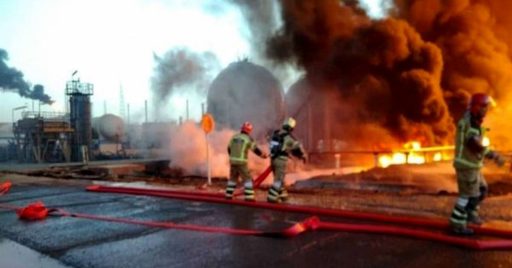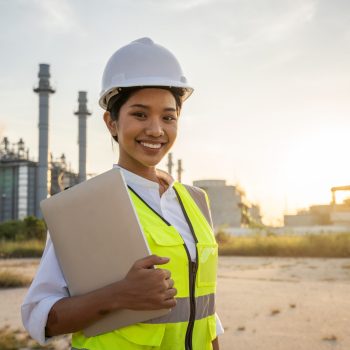Fire was everywhere, everyone was busy with something, and we just forgot him. Even now, 5 years after the accident, when the disaster is recalled, I feel deep sorrow, and his body comes to my mind. We found him too late. We lost him ridiculously, and he must have been alive now...
HSE Story: One Life Lost in Refinery Fire Incident
The HSE manager got upset when he was telling me the story. That day, they must control the fire rages as soon as possible. They finally extinguished the fire but lost one firefighter among the flames.
“We didn’t notice the leak; the gasket was old, and it was located where hardly was supervised although there was a camera covering the area.” He was explaining how the accident occurred.
“Workers saw a tense vapor cloud getting bigger so fast.” He said: “Everything happened too fast; we could evacuate the facility, and fortunately, the residential area was away from the refinery. But a spark caused a burst and fire, and we lost one firefighter.“
Leaks from refinery pipelines are not unusual. Several devices can detect leaks, but in refineries, especially old ones, those devices are not installed in every pipeline, and leaks happen. Additionally, those devices need regular Inspection as well.
That day, ethylene leaked from an old loosed gasket, creating a dense vapor cloud extending too fast and finally ignited. Firefighters endeavored to extinguish the fire, avoid propagation and prevent massive explosions. They succeeded in the cost of losing one. He stuck between fire flames, slipped, and fell to the ground. No one found out about the accident, and they discovered his body too late while a camera covered the area where he was on the ground, unconscious.
There was a chance to prevent this disaster; if the camera had alerted someone about the firefighter’s condition, he might still be alive. So, the question arising here is whether using AI integrated into cameras could have averted this tragedy?

AI for workplace safety - Empowering HSE crew
The accident mainly happened because 4 significant reasons:
- No one noticed that the regular pipeline inspection had been delayed, so the gasket got loosed, and a leak started.
- In facilities like refineries with many pipes and joints, there can be places where workers hardly check out, and similar accidents can occur. No one noticed the leak.
- Leak detection devices were installed in the line, but the one in that pipeline failed to detect the leak.
- During the fire fighting operation, no one recognized that one firefighter fell on the ground among the flame.
So the question is, how artificial intelligence technology could prevent the disaster? Let’s check some probable scenarios:
- Assuring regular inspection: The loose gasket could have been fixed or replaced if the routine inspection had been done. AI integrated into cameras can assure you that inspection is done on a predetermined schedule. On the other hand, if the leak detection device had functioned, authorities could have been aware of the leak much sooner. A regular inspection can also detect device failure.
- Detecting Leaks: As you’ve read above, a camera captured the gasket from which the leak initiated. If the camera had been combined with AI, it could have recognized the leakage or the vapor cloud in its earliest stages. Although some gas or liquids are not visible to regular cameras and based on the hazard, maybe you need to change the camera. Anyhow, your company has a lot of cameras that can take pictures and may even prevent accidents if they are integrated with artificial intelligence. However, that day this potential capability was not used. Is it still worth discarding this possibility now?
- Leak detection devices: There are leak detection devices in refineries that usually calculate the pressure in pipes; if the measured pressure is less than the calculated pressure, there may be a leak. Such devices should be checked regularly. With AI, you can ensure that these devices are regularly inspected, although the technology doesn’t limit this application. IN AN INTEGRATED DETECTION SYSTEM, the AI can also check leak devices’ functions and analyze their reports.
- Monitoring people’s position: The lost firefighter fell on the ground where there was a CCTV camera covering the area. By using AI, others could have been informed about his position. AI integrated into cameras can detect people and their body position; in an emergency, you can activate an evacuation scenario that helps ensure everyone is evacuated. AI can also monitor people’s situations and alert authorities when someone falls.
Above are 4 probable solutions to prevent a similar accident. The only note valuable to recall is that there have been already installed several cameras all over the refinery, factory, or company, so you must ask yourself, why not use them to empower the HSE crew yet?

Digital transformation: It's more about the human than about technology!
To benefit the most from AI for improving workplace safety, you need to initiate or accelerate digital transformation in your company. In this process, you can utilize your current digital devices and new effective ones in an integrated digital system that helps you decrease failures and increase efficiency. Such a system could have informed authorities about leak detection device malfunction or turned on a siren when the firefighter fell on the ground. If you want to know how you can do it, check the following tips and book a free demo to talk to us:
- Be transparent: first, be transparent with your employees. Talk to them about every change, its benefits, and probable dangers. Then be transparent with your customers; for instance, if you gather data, tell them why and how you do so.
- Mix up different generations: Despite understanding various technologies, new generations know almost nothing about workplace challenges. In contrast, old employees know much about the challenges and regulations and less about technologies. Mix them up to help both learn from each other.
- Improve safety culture: Everything is about human beings well being. Therefore, improve your workplace culture to let people accept and feel safe using technology.
This change now is optional, but soon it will be inevitable! Nevertheless, if you’ve decided to start your journey, do it wise to fly from the caterpillar and not get stuck in it!

Your Stories Matter
Every HSE professional has a treasure trove of stories to share—narratives that breathe life into workplace health, safety, and the environment. These tales are the catalysts for making HSE more than a routine; they bring attention to vital pain points and fast-track real solutions.
So, don’t hold back! Dive into your experiences because, believe it or not, your stories and precious insights have the power to transform the realm of safety and environment. Let’s revolutionize SE together for the better!
Stay connected with us, and don’t hesitate to share your valuable stories, even if you think they’re everyday occurrences. It’s the shared experiences that make the journey worthwhile!